#Company Union
Explore tagged Tumblr posts
Text
Sign and Share everywhere, brothers and sisters!!!
This union Bully speaks for the company: she does not speak for me or any other flight attendant represented by TWU 556. She is a company favorite of our Company Union!
#labor unions#workers rights#556 exposed#airline#union#flight attendant#556 betrayed#9916#company union#title vii discrimination#really executive board#my union sucks#better representation for flight attendants#legal liability#bad faith negotiations#my union is a joke#save our flight attendants#union betrayal#RLA discrimination#airlines#betrayal#twu 556 toxicity#railwaylaboract#twu 556 union bullies#bad faith breach duty of fair representation#bad faith representation#union negotiations#twu corruption#twu local 556#twu 556
2 notes
·
View notes
Text

"LUMBERMEN ORGANIZE TO OUST COMMUNISTS," Toronto Star. March 7, 1934. Page 4. ---- Blame "Foreign Roughnecks" for Labor Troubles of Last Winter ---- "BUSHMEN'S UNION" ---- Hundreds Join New Association at Head of Lakes ---- Special to The Star Fort William, March 7 - Asserting the timber industry in Thunder Bay district for years has been harassed and penalized "by intolerant, boorish and fanatical agitators of foreign semi-political organizations" to the detriment of business and labor, the new Canadian Bushmen's Union is launching a campaign against Communist activities in this area.
The new union, registered under the Trade Unions Act and affiliated with the All-Canadian Congress of Labor, was organized as a result of the winter strike in district pulpwood camps in which bush operations were paralyzed and 4.000 men left jobless for weeks. Hundreds of workers have joined the new union.
The Canadian union just has issued a statement declaring paid agitators were responsible for strife in the camps and urging workers to align themselves with established labor organizations against Communist operations.
"The Industrial Lumber Workers' Union and the Industrial Workers of the World, with such membership as they could secure, have combined forces for the purpose of calling strikes and, through force and threat, have compelled organized workers to obey their commands," says the union statement. "They have failed miserably to either represent the timber workers or to benefit them, and now they are striving for a general industrial upheaval.
Strikes Last Resort "The unorganized workers in the timber industry have determined that these Bolsheviki side-shows shall cease. They have organized on Canadian trade union lines under Canadian laws. To fight these professional trouble-makers on their own ground is the first step. As representatives of foreign organizations they are not entitled to a hearing. If they don't like this country no one will prevent them from taking the first train for Moscow of Chicago, and that's where they should be sent.
"This new organization is not interested in industrial strife and upheaval. It wants peace in industry. intelligent discussion and good will manifested regarding workers' problems, and a fair deal. A strike should always be the last, not the first, resort. This is the Canadian labor policy and a complete reversal of the policies followed by the two organizations mentioned, whose real objectives are the creation of strikes and strife. Incidentally it provides an easy living for the agitators, many of whom have done no other work for long time.
"Of interest to taxpayers and relief departments will be the information that these agitators have induced large numbers of men not to accept employment when it is available. These racketeers have no place in Canada."
Declaring that these Communist Unions are pledged to stir up strife, riots, sabotage, bloodshed and civil war, the new bushmen's organization announces its determination to fight their propaganda.
"The people at the lakehead remember what happened in the strike of last November," says the statement. "The Communist union took possession of the highways of the country and refused to allow citizens the use of them except b permits over the signature of the so-called strike committee. Had the Communists gained possession of the union's transportation and communication industries the disastrous effect on a nation-wide scale can readily be imagined.
No Apologies "We make no apologies for our stand. Our members will walk in the middle of the road when they meet a Communist. For this country still belongs to Canadians, and Canadian bushmen will not step into the ditch for any foreign-minded individual.
"Dishonest workmanship is the first principle with this Communist organization. They advocate staying at work and striking on the job. They issue circulars to workmen to slow up the work and hinder employers from filling their contracts. The following is taken from a circular posted in camps in the Nipigon district:
"If you are expected to haul six loads per day, haul only four loads. If you are working piece we just enough to pay your board. But do not do enough for the boss to be able to fill his contract. The hauling season is a limited period during which all wood must be got out of the bush. Delay on the job. The foreman cannot be at every turn of the road where a load might upset. The sap pealing season is short. All this kind of pulp must be cut within. a few weeks. Organize to protect your job to slow down production, to make the boss support us while on strike".
[AL: "Hostility to both the Communist Party of Canada and the Industrial Workers of the World following the 1933 strikes provided many of these disillusioned workers with an alternative, however. Affiliated with the All Canadian Congress of Labour, the Canadian Bushmen’s Union (CBU) was dominated by anti-Communist and “White,�� or non-socialist, Finnish lumber workers. The union and its members acted as informants for the RCMP and the Ontario Provincial Police (OPP) on the activities of local Communists. The union disappeared sometime during 1934, but it created difficulties during its brief existence. Formed under the leadership of George Salverson, a Port Arthur alderman and prominent member of the newly formed Co-operative Commonwealth Federation (CCF), the union’s executive also included a local timber subcontractor, L. Maki, and the local Finnish consul, a man named Koivukoski. The executive’s composition, and the role of Salverson in mediating an end to recent strikes, led the CPC and IWW to attack the CBU as a company union. In response, Salverson, using local newspaper coverage of a spurious plot by the Soviet Union to undermine Canadian timber production, attacked the LWIUC for its use of professional agitators who were more loyal to the CPC and Russia than to the region. Even though his accompanying claims that there was little dissatisfaction over working conditions were utterly false, his appeal to regional patriotism did strike a chord."
- from Michel S. Beaulieu, Labour at the Lakehead: Ethnicity, Socialism, and Politics, 1900-35. Vancouver: University of British Columbia Press, 2011. p. 195.]
#fort william#port arthur#thunder bay#bushmen#bush workers#timber industry#lumberjacks#union organizing#union politics#company union#right wing union#anti-communism#northwestern ontario#great depression in canada#strike#working class struggle#working class history
0 notes
Text












What if Dragon Age but they all work at Costco
it’s been 20 minutes and I’m already obsessed with this AU
More
#Isabela married hawke cuz he’s rich and she can buy all the box wine she wants#anders uses company resources to stockpile fertilizer and nitroglycerin pills for Reasons#Ferris tried to run anders over with a forklift and got sent to HR#where Dorian told him “I don’t know how to tell you you should care about your coworkers”#Fenris is 5 months sober and he can’t afford to lose this job#iron bull is a war vet who treats his coworkers like family and does not allow anyone to disrespect them#Sera steals from the company in every way imaginable#Isabela shoplifts because she can#Solas and Anders have long talks about the philosophy of labour and end up trying to secretly start a union#Hawke is just here to pick up some cereal#dragon age#dragon age inquisition#dragon age 2#garrett hawke#solas dragon age#dorian pavus#the iron bull#fenris#dragon age fanart#DAcostco
412 notes
·
View notes
Text
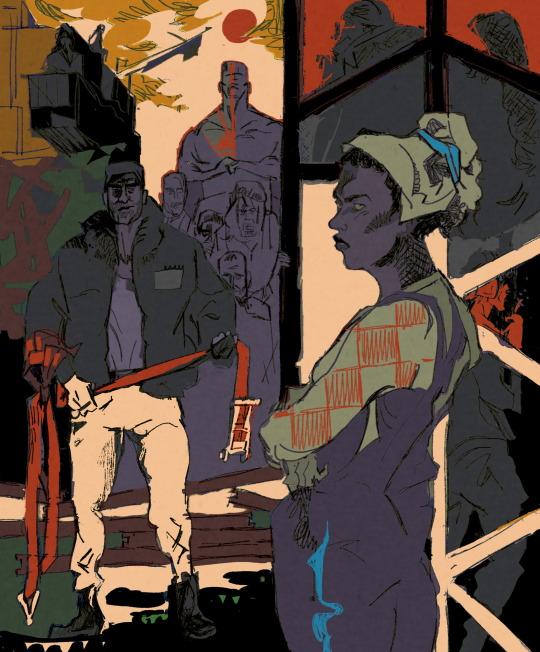
EVERY WORKER - A MEMBER OF THE BOARD
8K notes
·
View notes
Note
back when i worked at [large chain coffee store], i tried to unionize my workplace. my manager sat me down and gave me a very guilt trip-y talk. lots of "but i thought we were a family :(" and "you don't *really* know what unionization does, do you?" i played dumb and managed to avoid being fired, but. chilchuck momence.

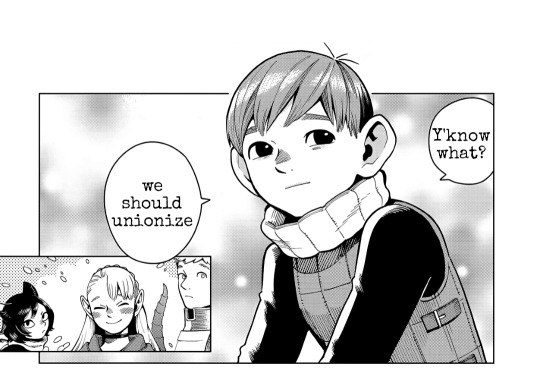
#mod chilchuck#i will say: i feel like chilchuck would be more adamant about forming a union given that he actually has done it#like. he has definitely received pushback for trying to form a union. even from other halflings (mickbell).#and i feel like he would know how to deal with it.#not to say that you didnt deal with your situation well. just that he had different priorities and wasnt at as much riskof losing his job(s)#given that he wasnt dealing with the fucked up job market we have right now. in which its dominated by very few companies.#diferent people are in different situations and sometimes you have to pick and choose you battles#which is why unionizing is so important. bc you dont always have to put yourself at risk to get better conditions#often times unions will have people who work the picket lines and lobbying etc. for better conditions.#working together makes us stronger. its not an individual's fight. its for all of us.#n e ways... that was long.#also. sorry for the late response to the ask. we (the blog) decided that it would be most fitting if i aswered this one.#and i was struggling to come up with a response.#(and having a severe episode of hypochondria)#dungeon meshi#chillchuck#laios#marcille#izutsumi
196 notes
·
View notes
Text
ngl despite how much I love art that follows awful people in bad situations, I think my favourite theme in mouthwashing has gotta be the ways in which blue collar jobs not only involve intense amounts of physical labour but also mental and emotional labour, especially in the face of an uncaring and supposedly familial corporate sheen. like it's surface level, but it's good and it's real.
#my posts#like I know somebody who used to work on freight ships and even with unions there's just an attitude of 'get your job done'#and in mouthwashing I genuinely love how the pony express branding and policies and promises underline everything that happens on the ship#like it really isn't just set dressing#even if it's a surface level theme I just genuinely really like it#you can believe this ship is real because the specificity of the company and the ship itself just screams an actual fucking old ass freight
61 notes
·
View notes
Text
Before anyone thinks that the SAG-AFTRA should have accepted the deal that included “a groundbreaking AI proposal that protects actors’ digital likenesses, and more” I would like you to read this quote from the chief negotiator Duncan Crabtree-Ireland
“They propose that our background performers should be able to be scanned, get paid for one day's pay, and their company should own that scan of their image, their likeness, and should be able to use it for the rest of eternity. If you think that's a ground-breaking proposal, I suggest you think again.”
And a comment from the AMPTP (the studios)
“The union has regrettably chosen a path that will lead to financial hardship for countless thousands of people who depend on the industry”
Both quotes are from this BBC article.
The same group of people saying that the strike will cause financial hardships for thousands of people is suggesting they get a single days pay for getting digitally scanned. Afterwards said scan will be used to do the work the actor should be getting paid for.
#do not let these billion dollar companies convince you the union is responsible for anything following this negotiation#actors strike#writers strike#SAG-AFTRA strike#sag aftra#sag aftra strong#wga strike#sag aftra strike#wga strong#sag strike
580 notes
·
View notes
Text
Stellantis wants to make scabbing woke
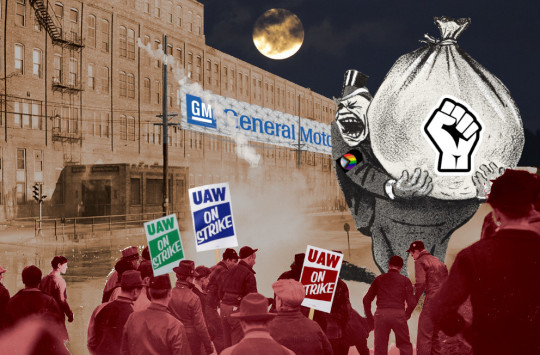
I'm coming to Minneapolis! Oct 15: Presenting The Internet Con at Moon Palace Books. Oct 16: Keynoting the 26th ACM Conference On Computer-Supported Cooperative Work and Social Computing.

I know, I know, it's weird when the worst people you know are right, even when they're right for the wrong reasons: like, the "Intelligence Community" is genuinely terrible, pharma companies are murderous crooks, and Big Tech really does have a dangerous grip on public debate. The swivel-eyed loons have a point, is what I'm saying:
https://locusmag.com/2023/05/commentary-cory-doctorow-the-swivel-eyed-loons-have-a-point/
When conspiratorialists and reactionaries holler about how the FBI are dirty-tricking creeps who are framing Trump, it's tempting to say, "well, if Trumpists hate the FBI, then I will love the FBI. Who cares about COINTELPRO and what they did to Martin Luther King?"
https://en.wikipedia.org/wiki/FBI%E2%80%93King_suicide_letter
It's a process called "schizmogenesis": forming new group identity beliefs based on saying the opposite of what your enemies say, and as tempting as that is, it's extraordinarily foolish and dangerous:
https://pluralistic.net/2021/12/18/schizmogenesis/
It means that canny reactionaries like Steve Bannon can trick you into taking any position merely by taking the opposite one. Bannon's followers are even more easily led, so it's easy for him to convince them that we have always been at war with Oceania. The right has created an entire mirror world of "I know you are but what am I?" politics.
Anti-vax co-opts "bodily autonomy." Climate denial becomes environmentalism ("wind turbines kill birds"). Transphobia becomes feminism ("keep women-only spaces for real women"). Support for strongmen becomes anti-imperialism ("don't feed the war machine in Ukraine"). These are the doppelgangers Naomi Klein warns us against:
https://pluralistic.net/2023/09/05/not-that-naomi/#if-the-naomi-be-klein-youre-doing-just-fine
The far right has even managed to co-opt anti-corporate rhetoric. Culture warriors rail against "woke capitalism," insisting that when big businesses take socially progressive positions, it's just empty "virtue signalling." And you know what? They've got a point. Partially.
As with all mirror-world politics, the anti-woke-capitalism shuck is designed to convince low-information right-wing pismires into buying "anti-woke pillows" and demanding the right to pay junk fees to "own the libs":
https://pluralistic.net/2023/08/04/owning-the-libs/#swiper-no-swiping
But woke capitalism is bullshit. Corporations – profit-maximizing immortal transhuman colony organisms that view workers and customers as inconvenient gut-flora – do not care about social justice. They don't care about anything, except for minimizing compensation for workers while maximizing the risk those workers bear; and locking in and gouging customers for products that are as low-quality as can be profitably sold.
Take DEI, a favored target of the right. It's undoubtably true that diversity, inclusion and equity initiatives have made some inroads on correcting bias in hiring decisions, with the result that companies get better employees who would have been excluded without this explicit corrective.
However, corporations don't value DEI because they abhor their history of hiring bias. Instead, DEI is how corporate management demonstrates to workers that their grievances are best addressed by trusting corporate leadership to correct their error of their ways – and not by forming a union.
Before the passage of the National Labor Relations Act in 1935, corporations would create fake "Company Unions" whose leadership were beholden to the company executives. These were decoy unions: they looked and sounded like unions, but when they negotiated with management, they were actually working for the bosses, not the workers.
This is more mirror-world tactics. They're the labor equivalent of the "crisis pregnancy centers" that masquerade as abortion clinics in order to fool pregnant people and trap them with endless delays until it's too late to terminate their pregnancies. Company unions get workers to trust in negotiators who are secretly working for the bosses, who emerge from the bargaining table with one-sided, abusive contracts and insist that this is the best deal workers can hope for.
Company unions were outlawed 90 years ago, and for decades, labor had a seat at the table, with wages tracking productivity gains and workers getting protection for discrimination, unsafe labor conditions, and wage-theft. Then came the neoliberal turn, and 40 years of wage stagnation, increased inequality, and corporate rule.
Anything that can't go on forever will eventually stop. Finally, finally, we have reached a turning point in labor, with public approval for unions at levels not seen since the Carter administration and thousands of strikes and protests breaking out across the country:
https://striketracker.ilr.cornell.edu/
It's not just the Writers Guild and SAG-AFTRA, either. For the first time in history, the UAW is striking against all the major automakers, and they are winning:
https://arstechnica.com/cars/2023/10/striking-uaw-workers-win-key-battery-plant-concession-from-general-motors/
The automakers are getting desperate. Stellantis – Chrysler's latest alias, reflecting the company's absorbtion into corporate-human-centipede of global carmakers – has mobilized its DEI programs, trying to get marginalized people to believe that scabbing is a liberatory activity:
https://theintercept.com/2023/10/10/uaw-auto-strike-stellantis/
Stellantis calls each of its DEI silos a "Business Resource Group" (BRG): there's a "Working Parents Network," an "African Ancestry Network," "Asians Connected Together," a "DiverseAbilities Network," a "Gay & Lesbian Alliance" and more:
https://blog.stellantisnorthamerica.com/2021/07/20/business-resource-groups-drive-inclusion-and-diversity/
The corporate managers who lead these BRGs have established a scab rotation for each subgroup, calling on members to cross a UAW picket-line at a Michigan Parts Distribution Center run by Stellantis subsidiary Mopar:
Each BRG will pick a specific day of the week/weekend to volunteer as a team. Help continue to be the RESOURCE the BUSINESS can count on! Stellantis needs your help in running the Parts Distribution Centers (PDC) to ensure a steady supply of parts to our customers while negotiations continue. Working Parents Network has identified Friday, October 13 as WPN’s BRG Day at the PDCs!"
Now, these BRGs weren't invented by marginalized workers facing discrimination in the workplace. They come from literal union-busting playbooks produced by giant "union avoidance" firms that charge bosses millions for advice on skirting – or breaking – the law to keep workplace democracy at bay. All the biggest anti-union consultancies love BRGs, from Littler Mendelson to Jackson Lewis. IRI Strategies touts BRGs as a way to "union-proof" a business by absorbing workers' grievances in a decoy committee that will let them feel listened to.
BRGs, in other words, are the Crisis Pregnancy Centers of workplace discrimination. They're a Big Store Con, a company union dressed up as corporate social responsibility.
Now, let's not pretend that unions have a sterling record on race and gender issues. Giant labor organizations like the AFL had to be dragged into racial integration, and trade unions have sometimes been on the wrong side of anti-immigration panics:
https://www.archives.gov/publications/prologue/1997/summer/american-labor-movement.html
But unions have also been the most reliable way for people of color and women to win better workplace treatment. The struggle for racial and gender justice was fought through labor organizing. Remember that MLK's "I've Been To the Mountaintop" speech was given in support of striking sanitation workers in Memphis:
https://www.afscme.org/about/history/mlk/mountaintop
Black organizers have always been militant labor organizers. Labor Day commemorates the victory of the long, hard-fought Pullman strike, where Black workers brought one of the most powerful companies in America to its knees:
https://en.wikipedia.org/wiki/Pullman_Strike
And women have always fought for gender justice through the labor movement: the New York shirtwaist strike is the Ur-example, when women-led unions fought thugs and scabs on icy New York streets:
https://en.wikipedia.org/wiki/New_York_shirtwaist_strike_of_1909
It's no surprise that labor activism, anti-racism and feminism go together. Since the earliest days, the labor justice struggle was also a social justice struggle. To learn more check out Kim Kelly's Fight Like Hell: The Untold History of American Labor:
https://www.simonandschuster.com/books/Fight-Like-Hell/Kim-Kelly/9781982171063
The most exploited, underpaid, and abused workers in America are also the most marginalized (duh).
From nurses:
https://www.reuters.com/business/healthcare-pharmaceuticals/kaiser-healthcare-union-says-week-long-strike-possible-early-next-month-2023-10-09/
To teachers:
https://www.latimes.com/california/story/2023-04-18/l-a-teachers-win-21-wage-increase-in-new-lausd-contract
To Amazon warehouse workers:
https://en.wikipedia.org/wiki/Amazon_Labor_Union
To publishing assistants:
https://apnews.com/article/harpercollins-union-strike-ends-0a94238718879066d9b21af6266be526
To baristas:
https://www.cnn.com/2023/09/29/business/starbucks-union-wages/index.html
To fast-food workers:
https://www.ufcw.org/about/
The vanguard of today's labor surge is Black, brown, female and queer. Without a union, workers who face discrimination are on their own, hoping that their bosses will voluntarily do something about it. Black workers in Tesla's rabidly anti-union shops face vicious racism, from slurs to threats to violence. Without a union, they have to rely on the shifting whims of an Apartheid emerald mine space-Karen for relief, or hope for help from the NLRB or a class-action lawyer:
https://apnews.com/article/tesla-racism-black-lawsuit-class-action-21c88bddf60eca702560be58429495de
The far right isn't wrong when they holler that woke capitalism is bullshit. As with so many of their mirror-world causes, they've got a point, but only a limited one. The problem with woke capitalism is that it's no substitute for a union. The problem with relying on Business Resource Groups to fight racism, sexism, homophobia and transphobia is that these struggles are all class struggles, and a BRG is never going to fight against the company that created it.
To understand how bankrupt woke capitalism is, conside this: Stellantis is calling on its "Working Parents Network" to scab this Friday. Stellantis is also being sanctioned by the Department Of Labor for discriminating against nursing mothers – the same "working parents" that the BRG is meant to protect:
https://www.clickondetroit.com/news/local/2023/02/08/investigation-finds-stellantis-violated-rights-of-nursing-mothers-at-sterling-heights-plant/
Woke capitalism is just another kind of "predatory inclusion," like Intuit's campaign defending its "Free File" tax-prep scam, where they're claiming that ending this ripoff is racist because it denies Black families the right to be tricked into paying for something they are entitled to get for free:
https://pluralistic.net/2023/09/27/predatory-inclusion/#equal-opportunity-scammers
When I learned about Intuit's wokewashing, I thought I'd found woke capitalism's rock bottom, but I was wrong. Stellantis's call for woke scabbing is a new low.

If you'd like an essay-formatted version of this post to read or share, here's a link to it on pluralistic.net, my surveillance-free, ad-free, tracker-free blog:
https://pluralistic.net/2023/10/11/equal-opportunity-class-war/#inclusive-scabbing

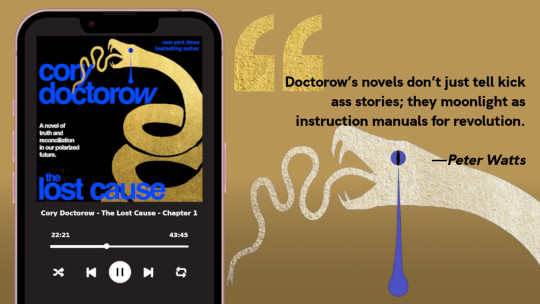
My next novel is The Lost Cause, a hopeful novel of the climate emergency. Amazon won't sell the audiobook, so I made my own and I'm pre-selling it on Kickstarter!
#pluralistic#race#gender#uaw#stellantis#gm#general motors#woke capitalism#wokewashing#strikes#labor#liberalism#company unions
276 notes
·
View notes
Text
There's a thought I've had
Supposedly Lancers fight for Union, well on the most base idea of a Lancer. Hell the place our thoughts go toare union funded and Albatross.
Sure KTB has theirs and all the companies got their own special flavor... But then you start thinking. Why the hell does Union use em.
Why do Lancers get sent to "bring peace" but then us mercs and those at MSMC get looked at like the scum of the stars for doing the same kind of shit. The same number of people die. The same amount of mana changes hands.
How many times have teams of Lancers done more harm than good?
When you're with one of the Merc companies you know what you're getting into...
But how many bodies coat the road to utopia?
I think I've been drinking too much
//Broadband\\
#lancer rpg#lancer ttrpg#lancerrpg#lancer#msmc#ktb#lancer union#mecha#mechs#mechposting#handler posting#pilot handler#mech handler#CORSAIR Mercenary Company#Union you weird conplicated mess
41 notes
·
View notes
Text



You hear heavy footsteps from down the hall…..
Meet UNION, my Lethal Company oc!
Just stay quiet. . .
#my art#UNION#oc#lethal company#lethal company oc#original character#horror#scocophobia tw#eye contact
83 notes
·
View notes
Text
MACON, Ga. — Over 300 workers at Kumho Tire company have unionized– making them the second biggest company in recent months to join the United Steelworkers. The other is Bluebird in Peach County. Four years ago, James Golden said he needed a career change. “I knew Kumho was a new plant, so I wanted to go somewhere I could grow,” he said. Golden says as a belt operator, he likes the job but noticed that the company could use some change too. “With it being a new plant, there was a lot of confusion about pay, confusion about fair labor practices,” he said. “I said, ‘yeah, we definitely need a union here.’” Golden said he wanted to learn more about how to unionize and took a trip to their union hall.
#news#macon#macon georgia#labor organizing#labor news#hot labor summer#kumho tire company#unionizing#unions#union strong#united steelworkers
347 notes
·
View notes
Text


Flashback to 2015, right after 9,916 flight attendants voted down the WORST TA proposal in the history of TWU 556.
And of course, the Inflight VP ( Director at the time) took up for the sniveling EB/ Negotiating Team in their attempt to silence oppositional, Railway Labor Act protected speech.
SWA Management officials and TWU 556 union officials silencing the majority of flight attendants at Southwest Airlines Co.
Acts of Intimidation to go along with company handpicked union officials of the "Company Union."
The more you know.
#TWU 566 History lesson#twu 556 toxicity#twu 556 union bullies#twu 556 breach duty fair repesentation#twu 556#TWU 556 betrayal#twu 556 rank and file#TWU 556 members betrayed#9916#TA2013#betrayal#airlines#company unions#railwaylaboract#labor unions#workers rights#airline#flight attendant#company favorites#Company Union#twu 556 company favorites#President Audrey Stone#backroom deals#toxic Labor Management Relations#union#aviation unions#transportation unions#flight attendant unions#toxic union leadership#twu 556 company union
1 note
·
View note
Text
IBO reference notes on . . . the economic blocs
In episode 4, we are shown this map, depicting the current national organisation of the Earth in Iron-Blooded Orphans' setting.

This raises a number of questions, primarily 'what were they smoking when they decided to combine Canada and Russia'?, secondarily 'what does Gundam have against Australia?', and further, 'what's the deal here?' In the spirit of obsessive nerdery -- and inspired by @qqchurch posting about a particular map prop -- I thought I'd have a crack at pulling together some answers.
Some spoilers and a rhetorical swerve ahead.
The bigger picture
Geographically -- astrographically? -- the solar system of Iron-Blooded Orphans is split into different 'spheres', principally the Earth Sphere and the Outer Sphere. This is a holdover from the original 1979 Gundam series, which used 'Earth Sphere' to refer to the region of space containing Earth, the Moon, and the various orbital colonies located within this gravitational system.
I should note, mostly for myself, that while writing fan-fic for IBO I fell into the habit of writing Outer Spheres, pluralising a term I believe is only ever singular within the canon. This stems from the grouping of both Mars and Jupiter (and presumably the Asteroid Belt) into the Outer Sphere. I would argue that post-canon, the pluralisation makes sense since we then have the Mars Sphere as a discrete political entity, but even without this, grouping two distinct planet/moon groups into one sphere seems to cut against the Universal Century definition given above.
Nevertheless, as a in-universe division it makes sense. Earth is the centre of power in this setting, the other planets existing as its colonial holdings. An 'Inner Sphere' or 'Venus Sphere' (depending on which logic we follow to style it) is also visited in spin-off game Urdr Hunt, having been left to decay now its utility in terraforming Mars is over.
In terms of political organisation beyond the Earth Sphere, we spend most of our time with Mars, which is sub-divided into colonies following present-day naming conventions for Martian topography. The principle action takes place on the Chryse Planitia, with the city of Chryse being this region's capital. The city of Noachis, presumably capital of the neighbouring Noachis Terra, is also mentioned.
In practice, Mars is administered as a whole by Gjallarhorn, on behalf of the Earth political blocs that own the various individual colonies, with the officer in charge of the occupation ruling from the Ares space station. The Venus colonies, including the tethered Radonitisa Colony, are likewise overseen from an Aphrodite station, and we might therefore infer a Zeus station exists too. This is in fact one of the few guesses we can reasonably make about Jupiter, since we never actually visit it during the course of the series. Jupiter's moons are likely inhabited, since four subsidiaries of the Teiwaz conglomerate are named after them (IOS, Ganymede Farm, Euro Electronics, Callisto), and it is also probable there are a number of O'Neil cylinder space colonies in the vicinity (flashbacks with Naze and Amida show them sharing a hotel room aboard such a structure). But we never get any hint of how Jupiter is governed, except that the most powerful organisation there seems to be the aforementioned Teiwaz, a corporate mafia/yakuza (they are at once both Italian and Japanese; it's glorious). No other official body ever comes up.
The division of Mars dates to a few years after the Calamity War, when Gjallarhorn was directed to recreate the Martian government from scratch, following on from overseeing the reorganisation of the Earth into four 'economic blocs', abolishing old national borders. And it is here I shall be focusing this post, to take a look at what we are told about each bloc. For the sake of a structure, I am going to take them in reverse order to how much we know, which means we start with the Oceanian Federation.
The Oceanian Federation
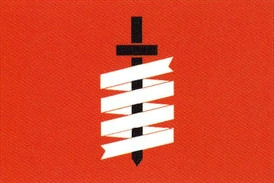
Well, first off, their flag goes the hardest of the four. Just look at this.
That aside, of all the blocs, it is a little peculiar that we know the least about the Federation given theirs is the only non-Arbrau, non-Gjallarhorn territory we spend any time in while on Earth. It is they who offer refuge to Arbrau's ousted Prime Minister Makanai after all, setting him up on a tropical island retreat while he awaits the chance to regain power.


This is an impressively sprawling place, befitting a man of Makanai's station. It displays distinctly Japanese style architecture and decoration, which makes sense given this is the bloc in which Japan is situated (it combines Asia with Oceania). Given Makanai's name and preferred form of dress, it is plausible he is himself from the Federation originally, although there is sufficient cultural overlap on display elsewhere that this is far from a necessary conclusion. Regardless, for their own reasons, they give him sanctuary, up to the point Carta Issue pressures them into rescinding their protection and allowing her to pursue Tekkadan.
In a similar vein, the Federation offers Tekkadan's space-based forces safe harbour at their colonies, as quid pro quo for interfering with the African Union's operations. A different set of (specifically industrial) colonies is later shown in Season 2, undergoing an attempted workers' uprising. Having watched the African Union suffer from the Dort uprising in Season 1, the Federation's leaders are not prepared to risk the same happening to them and they give Gjallarhorn a free hand to violently suppress those involved.


Beyond this, we learn nothing whatsoever of the Federation's people or government. The world map aboard the Montag Company ship that carries Tekkadan from Makanai's island to Arbrau centres Japan, an indication that while Gjallarhorn uses Euro-centric maps, this doesn't represent cultural (or navigational) homogeneity. But this is I think more interesting on a meta level, in regards the positioning of the two maps within friendly and antagonistic factions, respectively. As a world-building detail, it's merely logical for a Pacific-based freighter to carry such a chart.
Going beyond the text and doing a quick spreadsheet calculation based on Wikipedia's summary of 2023 data, the Oceanian Federation would account for a full 50% of the Earth's population, with the African Union encompassing approximately 35%, the SAU 13% and Arbrau a paltry 2%. That, however, does not account for the Calamity War and the consequent extermination of a quarter of the human race. In light of this, we might spin the division as a subtly horrific bit of environmental storytelling. We know mobile armours will prioritise targetting the largest concentration of human beings they can detect. What would this have meant for places like India or China when things ran out of control?
Obviously we don't know the state of population distributions pre-War and the quarter figure is given for the solar system as a whole. Still, if we are to assume the four-way sub-division made some sort of sense in the immediate aftermath of the Calamity War, a proportionally heavy casualty rate for the most populous nations on the planet could provide a possible justification for such an uneven-looking arrangement.
(In case you're wondering, subtracting the entire quarter from the Oceanian Federation shifts the percentages as follows: OF: 34%, AU: 47%, SAU: 17%, A: 2%. I present this as an illustration of alternative distributions rather than a feasible scenario; I don't actually believe there's a way to make the division follow purely from current world population.)
Oh, yes, and per tradition, Australia has a big honking hole in it, a call-back to the original Gundam anime's opening colony-drop, that presumably marks an event from the Calamity War. Like the damage done to the Moon, this is never expanded upon, but it does lend some credence to assuming Oceania bore the brunt of the conflict.
The Strategic Alliance Union (SAU)

Hello, yes, this is American one.
The SAU's principle role in the plot is to be incited into war against Arbrau as part of Galan Mossa's plan to embarrass McGillis. This scheme takes advantage of a pre-existing border dispute, the exact details of which are not provided: they're far over the heads of our point of view characters. The conflict occurs on 'Balfour Plain', which I take to mean in the vicinity of Balfour, British Columbia. Beyond that, things are left vague.
It does highlight that friction between the blocs is present along lines going beyond mere economic competition. Indeed, it underlines the blocs as competing entities. They operate as nation-states, advancing their own agendas. This extends, following the events of Season 1, to amassing overt military strength.


We can't attribute the mobile suit storehouse show in the opening montage for Season 2 to any particular bloc. But it does house several Hexa frames in addition to Rodis, which ties in with the later appearance of Gildas at the head of the SAU's army. These are Calamity War-vintage 'suits brought out of mothballs after Tekkadan shook things up by deploying at Edmonton, and they make for a notable contrast with Arbrau's own mecha contingent, which consists of brand new Hloekk Grazes bought from Gjallarhorn.
Gjallarhorn also deploys to provide battlefield support to the SAU, indicating the extent to which this peace-keeping force can intervene in inter-bloc conflicts. Perhaps McGillis' forces act on behalf of the putative defender, given the war was instigated when an SAU jet crashes following exposure to an Arbrau Hloekk Graze's unshielded Ahab reactor. Having not considered the situation critical enough to require mobile suits, the SAU views this as unprovoked escalation and appeals for support.
Which brings us to the rest of the SAU's military forces, consisting of planes use for reconnaissance and mobile workers. This tells us jet fights still have a place Post-Disaster, and that the mobile worker industry is eccentrically prolific.


Like Arbrau, the SAU's military is described as inexperienced. I am not sure where to fit an evident air force into that picture: it could be the lack of experience does not denote newness, as it does for Arbrau's defence force, but simply the absence of any active role prior to the declaration of war. Although the bloc's name -- Strategic Alliance Union -- sounds atypically militaristic compared to the others (rather like naming a country after NATO), it is not ascribed greater martial prowess. The conflict boils down to two rag-tag armies chipping ineffectually away at another, falling for Mossa's attempt to bog the region down in a petty, protracted war and thus ruin McGillis' reputation as a peacekeeper.
That about covers the extent of the information we learn about the SAU in the main series. For more, we must turn to Urdr Hunt and...
Well. OK. I am obliging myself to include this, aren't I? The Zahn Clan are introduced in the game as a crime family from the SAU. The two sons of the Clan's founder, Rubian, are dispatched to take part in the titular hunt to test whether they have the chops to succeed him as head of the organisation. I won't go into the plot here; you can look up my summaries or simply go watch it for yourselves. (Note: official translations of the names have since been provided on the website for the upcoming animated adaptation, but some of these seem of slightly dubious quality compared to earlier fan-sourced versions [I don't think 'Lubian' can be right].)
The thing is, the Zahn family -- Rubian, Rome and Aiko -- are African American gangsters. Stereotypically so. Their mobile suits are styled after cars, they're decked out in rings and gold chains, Aiko has a baseball cap, Rome, extravagant piercings, etc. They're a caricature of United States criminality and the problem is, IBO's art-style tends grotesque when it comes to the underworld, meaning the result is, in motion, when the detail level drops, extremely uncomfortable. It certainly doesn't help that the brothers are depicted as buffoons, playing straight the 'comedy relief idiot' trope Iok subverts in the anime proper (that is, Iok is an idiot and it is not remotely funny).
Their dad is *not* a fool, nor is fellow gangster Jabiro, but I really, really wish this didn't hit quite so many racism buttons at once. Nonetheless, they are a depiction of an aspect of the SAU and must be included in a post covering what we know about the blocs.
Rubian has been wildly successful at running his underworld empire. Though old and infirm, he remains extremely sharp, ruling the Zahn Clan from an honest-to-goodness castle in his home territory. I have no idea which way this cuts with regard to racist caricatures. It seems to be suggesting a level of in-universe tastelessness but quite frankly, I don't think I can fault a mobster who gets wealthy enough to go, 'I'll live like a literal king'.


In terms of the Zahns' relationship to their home bloc, I noted in another post that they are remarkably well-equipped, fielding top-of-the line 'suits alongside more venerable models (including a lot of Gildas) and surplus Gjallarhorn spacecraft. While we know 'top-down' corruption is rife in the Earth Sphere in the sense of Gjallarhorn members empowering themselves by overstepping the bounds of neutrality, the Zahns demonstrate that 'bottom-up' corruption is alive and well too. Indeed, they are described as being explicitly 'backed' by the SAU , with a presence in all of the SAU's territory on Earth and having both Gjallarhorn and government officials in their pocket.
As is to be expected, the blocs are as sordid as contemporary nations, with the criminal classes very much in on the act.
The African Union

That's the Republic of Gambia's flag rearranged into something less cool.
I hesitate to classify the African Union conspiring with Gjallarhorn against the workers unions as an act of corruption, on the principle that 'corruption' implies the system is not functioning as intended. Far from being broken by moving to curtail the activism of people who are (theoretically) its citizens, the Union works to perpetuate its interests, something judged to have been harmed when it eventually concedes to some of the workers' demands. These are economic blocs, after all. Extracting profit and generating wealth is the tacit reason for their existence.
Let's back up. I've re-litigated Season 1's Dort Colony arc in multiple essays at this point, largely because it is a capsule of the series' themes. The struggles of the people who operate industrial facilities for the benefit of "rich factory owners from Earth" -- who live in splendour compared to the slums where the masses are relegated -- culminates with a bloody massacre, Gjallarhorn having manufactured an excuse for violence by allowing tensions to escalate to the point of armed insurrection. These events provide a snapshot of how the writers conceive of colonial and anti-labour oppression, a demonstration of the injustices that permeate every level of the society they have imagined, and an ambiguous moment of success for the protagonists. Kudelia Aina Bernstein gets to be the brave, fearless 'maiden of revolution', photogenically turning the media apparatus against government overreach. But it is underpinned by dubious backroom deals and a sense of how easily things could have gone the other way. This won't be the last time Tekkadan faces the Arianrhod Fleet and their visible insignificance before hundreds of ships and mobile suits is sinisterly prefigurative in retrospect.
For my purposes today, there are two important components to this arc. Well, three really, but we can take Gjallarhorn's utility as the blocs' enforcer as read. So -- the first is how the African Union relates to those living aboard the space colonies, and the second is the way in which those colonies are run for its benefit.
The Dort Company is described as running the colonies as a 'public enterprise' for the Union. As I mentioned in an aside while writing about how IBO engages with capitalism, this creates a surface-level contradiction where we have factories privately owned, presumably for profit, but the colonies themselves framed as a public service. Yet I don't think anybody familiar with how privatisation consumes such services will have a hard time reconciling this. The degree to which the Union is or is not doing state capitalism is ultimately irrelevant: the conflict is between the workers and the company that employs them, as a proxy for the bloc that consigned them to a miserable existence as expendable labour.


The Dort Company is an extremely prominent presence, their branding displayed at scale and their workers all sporting green jackets. 'Dort', by the way, is the historical English name for Dordrecht, the oldest city in Holland and a shipbuilding centre for the Netherlands Trading Society, which maintained shipping lines to the 'Dutch East Indies' (Indonesia). Dordrecht also gave its name to a town in South Africa, in a further link to European imperialism. I can't be sure to what extent IBO's writers were deliberately evoking that history, but it seems unlikely to be an idle connection. The Dort Company is a tool of an Earth-centric empire, maintaining the industrial mechanisms that sustain the African Union, space colonies having taken the place of 'third-world' manufacturing centres. This is where consumer goods are produced, for those who live well, by those who scrape by in poverty.
The visuals sell this with straightforward bluntness. We are shown the slums that house the workers and we are shown the shopping centres frequented by the factory-owning class. Yamagi comments, on seeing the home of labour union leader Navona Mingo on Dort 2, that he expected the colonies to be a lot nicer. He was perhaps picturing the kind of environment Mikazuki, Biscuit, Kudelia, Atra and Fumintan explore aboard Dort 3, a 'first-world' cityscape. The point being made is that these contrasts go together, often in the very cities that look so good on the surface. There is always a disposable underclass, always exploitation required to fuel superficial prosperity.


What I find interesting is that in none of this do we ever see the 'true' African Union, the society the Dort Colonies exist to serve. We never meet any representatives of the Union itself: Gjallarhorn deals with Dort Company executives and faceless communiques. Even in spin-off manga Moon Steel, where the bribery of Gjallarhorn officers by African Union officials is a key plot point, the action remains focused on the space colonies, on the people living in what is essentially captive territory.
This is likewise true for the previous two blocs I've covered and it's a canny choice, centring the struggles of the colonial subjects. The African Union has a 'ruling council'. But our sole insight into them is that they decide to reverse course and put a stop to Gjallarhorn's anti-labour operation at the last minute, afraid of the media exposure Nobliss Gordon arranged for Kudelia. The Dort Company then comes to the table with the (remaining) workers, granting labour rights equal to those existing on Earth.
Obviously this tells us such rights are not the general rule in the colonies, that employees on Earth enjoy privileges denied to those in space, and that the Union leadership is sufficiently sensitive to bad press, they don't want to be seen to sanction the killing of hundreds of colonists. At the same time, what is not said is also significant. We don't know, precisely, what 'rights equal to workers on Earth' materially entails. McGillis' backstory establishes the existence of a terrestrial underclass. There is every reason to believe Yamagi's misapprehensions hold true for the planet as they do for the space colonies: there is no land of wholesale luxury, just the same hierarchical, exploitative structures repeated in different locations.
I admit to finding the idea of Europe being subsumed into an African Union a deliciously ironic one. As a background detail, it's shallowly pleasing. Implied turnabout. But that doesn't matter, does it? Any redress of historical crimes is overshadowed by the fact nothing has been fixed. The same old imperial structures are reiterated, the same old injustices perpetuated. Who is being exploited is of lesser concern than that exploitation is occurring. That's why the details of the blocs' governmental structure and home conditions are largely irrelevant. They are powerful national entities engaged in the operation of capitalism at the expense of their subjects. Whether those operations occur in Indonesia, high orbit or on Mars, the flaw lies in the basic structure of the relationship.
Someone is being worked to death so that someone else, distant or otherwise isolated from this material reality, can profit.
Arbrau

OK, now you're just throwing shapes at a background.
It is inevitable that the bloc we are told the most about should be the one that owns the territory in which the story begins. Chryse is an Arbrau colony; ergo, it is with the Arbrau government that Kudelia must negotiate in order to improve the lot of her fellow Martians. Season 1 is about reaching the heart of this bloc's power, the parliament in Edmonton, Alberta, an aim that morphs into restoring Togonosuke Makanai to the office of prime minister and stymieing the machinations of his Gjallarhorn-backed rival, Henri Fleurs. At last, we can take a look at how Iron-Blooded Orphans conceptualises the political functions of its quartered Earth.
Gundam Wiki states that Arbrau "appears to be a parliamentary democracy" and, while I occasionally have cause to take issue with the editors at that site, this is entirely correct. There is a parliament, as mentioned, a prime minister, a debating chamber, and elections. It is an overtly civilian institution, in contrast to Gjallarhorn's militaristic aristocracy. It is overtly civilised, in the sense of being a bunch of people in business suits ruling a nation.


I should clarify immediately, not least because this threw me on first viewing, that it is not the form of parliamentary democracy found in modern-day Canada. The way the election of the prime minister works is modelling (unsurprisingly) on the Japanese system, where the legislative body holds responsibility for nominating someone to that position (rather than it being de-facto filled by the leader of the dominant party). Hence Makanai and Fleurs courting the support of various ministers and the election being entirely contained within the bounds of the sitting government.
In the epilogue to the series, Lasker Alessi talks about having a constituency, hoping Takaki will take over from him there in the future. We can take from this that Arbrau is a representative parliamentary democracy (not a given; parliaments can operate without representing the citizenry), and therefore that it is more or less the assumed default in the context where the show was written. This is what politics is 'supposed' to look like.
These markers of familiarity are worth bearing in mind when considering the ways Arbrau is depicted as being overtly sympathetic. Makanai has long championed greater economic freedom for the Chryse region; indeed, Arbrau was the first of the blocs to grant limited autonomy to its Martian colonies, some hundred odd years prior to the present. The parliament members respond favourably to Kudelia's landmark speech before them. Later, Alessi takes Takaki on as his protegee, and Edmonton is where the Human Debris Abolishment Treaty is signed.


Furthermore, Chyrse is the only colonial holding Arbrau is shown to possess. While Governor Norman Bernstein is a craven, cowardly man who sells out his own daughter, he is also depicted as being in Gjallarhorn's pocket, part of the (textual, actual) corruption miring the governance of Mars. It is Gjallarhorn who work to uphold the present colonial arrangements, opposing those more open to change. They are behind Fleurs and her temporary ousting of Makanai. Lord Iznario Fareed might be acting for his own personal gain, but he also represents the factions who wish for things to continue as they are, in opposition to McGillis's revolutionary movement and Rustal Elion's (eventual) reforms.
If Arbrau has its own equivalent of the Dort Company, this is kept off-screen. Is it reasonable to assume it does? We know from Urdr Hunt that Dort is one colony management company among many -- the Omden Colony Company is arguably even worse -- so it's far from implausible that Arbrau would have a similar arrangement with its own set of industrial colonies. There is also mention of an 'Outer Sphere Development Corporation' on Mars, which sounds very much like what you would name something that went around exploiting poorer nations for the betterment of shareholders in richer ones. And besides, Chryse has definitely not done well out of Arbrau's nominal stewardship. Abandoning the colony to Gjallarhorn's rule speaks to how little regard has been shown to the people living there, not to mention that while Makanai says his belief in advancing their cause is long-held, it has amounted to very little concrete difference over the course of his presumably lengthy career. Kudelia's trip to Earth is a clearly necessary spur to action.
Action results, though. The restrictions on Chryse are eased, a step toward Mars becoming an independent state. Arbrau is the vanguard of a change in attitude towards the red planet. Perhaps then we should ask why this bloc among the four would be the one to begin this process (beyond the mere narrative convenience of 'that's where the majority of the cast come from').
As I alluded to at the top of this post, I struggle to see the sense in joining Canada, Alaska, Russia and Svalbard together when you're also combining India and China, the entirety of Europe with the entirety of Africa, and the majority of the Americas into one. It really doesn't follow from modern population distributions, nor can I imagine it being an easy stretch of geography to manage. That it should be ruled from Edmonton is additionally baffling; it's not like Russia doesn't have existing civic infrastructure, placed at an awkward distance from this capital.
We can of course attempt to fill in the blanks. We might say a large number of refugees were displaced north during the Calamity War, fleeing densely populated areas for the relative safety of Russian and Canadian wildernesses. There is something compelling about this idea, that Gjallarhorn had to redraw the map simply based on where people ended up once the dust settled.
But let's take Arbrau as given: an expanse of tundra, connected by trains the prime minister doesn't seem to have known were there. Even admitting there are a great many large cities continued within its borders and assuming an increased population, it looks paltry in comparison to the other blocs, seeming to lack large amounts of colonial territory and needing to create a defence force from the ground up when tensions escalate. Where the SAU and the African Union display pre-existing mobile suit stockpiles (placed in the hands of the SAU military and the Dort Company, respectively), Arbrau must buy new 'suits from Gjallarhorn and rely on mercenary groups like Tekkadan to train its recruits.
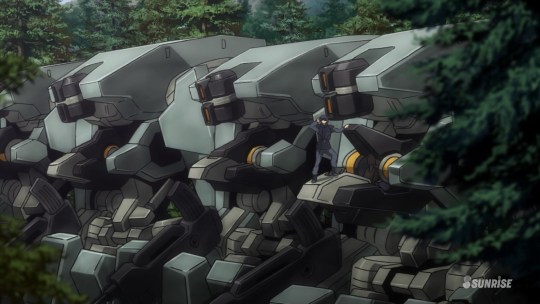

Overall, everything we learn of Arbrau makes it appear weaker than its counterparts and maybe that in itself is why it should be at the forefront of letting go of Mars. Empires are only worthwhile so long as the costs are outweighed by the gains. A weaker bloc is less likely to make that equation work. Ergo, once Chryse is more trouble than it's worth -- say, because the governor's daughter just parked a paramilitary group run by teenagers on the front lawn -- letting it go becomes an inevitability.
As much as Makanai is broadly on the side of our protagonists, he remains an ambiguous character. He is openly self-serving, threatening Tekkadan into assisting him and frequently espousing a hard-hearted, cynical world-view. If he wasn't just flattering Kudelia, then he genuinely gave little thought to the infrastructure that operated at the ground-level of his nation. He later goes on to treat a greater sense of the moral weight of his actions (following a brush with death) as a personal failing. Given all this, it is unfeasible he would act without considering the economic realities of possessing colonies, good and bad. Thus, his decision to support Kudelia must also benefit Arbrau, freeing them of an economic burden and -- perhaps -- sowing discord among Arbrau's rivals.
This is, once again, speculation, filling space in the narrative where details are not required. To return to my earlier point, the nature of the blocs is far less important than their presence as oppressive forces. They and their representatives signify wealth and power imposing itself upon a wider world. Indeed, signifiers of wealth take the place of any technicalities of the colonial system. The Governor's residence in Chryse is of a piece with Dort 3 and even with Rubian Zahn's castle. This is what the ruling class looks like, in Iron-Blooded Orphans, and the visual obviates the need for explanation.
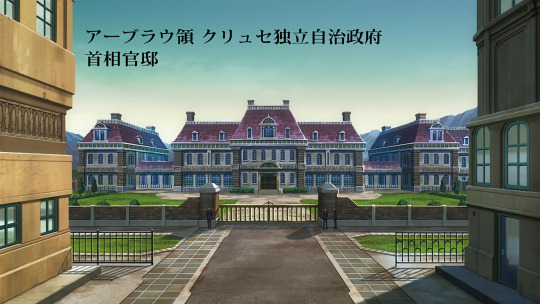

The Arbrau parliament is the same kind of shorthand. The image of a reasonable political system that, though it may suffer from bad actors, can still be gamed to create good results. It's only natural for it to resemble the form of government socially agreed upon to be correct, by dint of it being the one outside.
Yet, as with everything else IBO does, there is a pleasing degree of problematisation on display. Makanai is the only significant human face provided for the blocs and he is, beneath his oft-times jovial affect, a cold, aloof pragmatist who acts to secure his own position first and foremost, personal beliefs subject to the flow of power around him. His status as a helpful, progressive figure is tinged by his being at home within the broader context. Reasonable and proper though parliamentary democracy is in principle, the reality is still assumed to be unpleasant.
Indeed, can a 'democracy' that owns/owned colonies be anything else?
Cartographical gestures
Let's get this out of the way: the economic blocs as depicted are exactly as fleshed-out as the block-colour map shown in episode 4. That is to say, they are shorthand for global superpowers engaged in a vast, sprawling competition. There is little culture, political nuance, or comprehensible structure instilled into them. These are simply not things Iron-Blooded Orphans cares about exploring and there's no connective tissue to be 'decoded' from what we're shown.
As ever, we can speculate wildly (and have a lot of fun doing so), and unpick what the sketched background tell us about the creators' assumptions and approach. We can question how they envision government bodies, military build-up, American criminality, even what 'rich' looks like. But it is important to be able to step back and really grasp what we are looking at.
The episode 4 map is there to inform the audience that the world is divided between massive superpowers, that the division was enacted by Gjallarhorn, and that the results define where and why our heroes are going on their journey. The actual details of the division are irrelevant. Further, the differences between the blocs are far less significant than their similarities. At the start of the show, they all possess colonies, they can all be assumed to be party to oppressive acts, we have no reason to think their systems of government differ much (they were all set up by the same group of people, at the same time), and their reactions to developments in the setting are of a piece. They even release their hold on Mars in unison! Arbrau gets cast in a more positive light than the others, but that has more to do with Makanai's role as a (relatively) reasonable authority figure. It's not hard to imagine the introduction of equally reasonable characters representing the other blocs, with no change to the underlying message that the blocs at large are callous, indifferent, and imperialistic.
Suffice to say, I think this is the right decision for the story Iron-Blooded Orphans is telling. It is also an entirely unremarkable move, hand-waving a larger world as justification for a particular plot. But I find myself considering the a conceptual floor represented by that map. A geopolitical why underlying Makanai's behaviour is not extant because the story is about the difficulty of reaching those in power with pleas for improvement. Within this framework, he just is a supporter of Martian autonomy and that's that. Digging beneath this is writing fan-fic, not extracting 'lore' or canonical detail.
Ultimately, I take from that a lesson in a piece of fiction's priorities. We have here a marker of a certain geopolitical relationship, within a tale about oppression primarily told from the perspective of the oppressed, that is not strictly concerned with the mechanics of said relationship but rather what it entails.
The map is wallpaper.
Interesting, simplistic, potentially insensitive wallpaper that can be used as the basis for some good stories.
Yet wallpaper all the same.
[Index of other writing]
#gundam iron blooded orphans#gundam ibo#g tekketsu#tekketsu no orphans#reference#notes#arbrau#SAU#oceanian federation#african union#dort company#Togonosuke Makanai#fictional politics#flags
38 notes
·
View notes
Text

So after seeing this tweet from 4-ish hours ago I had a think. If I understand this correctly...
If this indicates they are indeed going on strike, word-of-mouth will become the only means of promotion for already completed works being released or awaiting a scheduled release caught in this struggle. No actors on red carpet at premieres, no promo junkets with fan service, or interviews about projects so many have worked so hard to create. Actors will be committed to no work of any kind(including promos) moving forward from the stoppage of a strike.
Word-of-mouth by the public will become make or break for the duration for these unlucky works in the interim.
Please, let us all pay attention and support these unions in seeking better working conditions and commensurate pay by following their lead. Whatever that lead is, including supporting works already produced.
#sag-aftra#union solidarity#wga strike#aim your displeasure at the companies trying to bust unions#not at those who simply want to create under fair conditions with reasonable pay for that work#it is neither the writers nor actors fault for this situation#i stand with the writers#i stand with the actors#the SAG-AFTRA national board has not voted yet but seem poised to do so in favor of a strike at time of posting#watch the union for updates and official releases not gossip columns
296 notes
·
View notes
Text
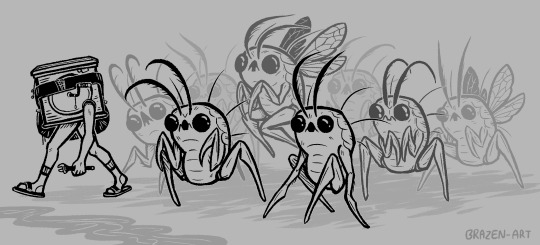
Gang's on the move
(a pipe burst in the hoard storage room)
#lineart my beloved#anyway here's the rest of Roscoe's bully squad#(minus one other oc)#(whom i am still developing)#but tagging the bugs here we go - Maude - Dorothy - Sybille - Ruth - Constance - Lottie - Irene and Winifred#whew#Roscoe named them#(Roscoe is. not very creative but insists on naming entities anyway. and she defaults to old lady names lol)#Roscoe's fearsome grandma gang#unfortunately the names aren't a marker for any real attachment#when one of the bugs.. disappears... the next one to show up just. inherits the unused name lmao#poor bugs man#boss doesn't care about them#they should start a bug union#mind you. between all of them Roscoe is the only one with a thumb#and that's very handy (teehee) for things like surprise leaks#also shes scary.#like that's a wholeass jester whats a bug gonna do#there's at least a safety element i suppose#lethal company#lethal company oc#lethal company fanart#lethal company jester#lethal company hoarding bug#lethal company lootbug#Roscoe#my ocs#I'm not tagging the bugs a second time#they've had their time in the spotlight
70 notes
·
View notes
Text

Careful… It's eyes are on you…
#my art#Textor#OC#original character#Lethal Company#Lethal Company OC#other people's OC's#UNION (oc)#stickyshoelaces#looking at camera#scopo tw#scopophobia
43 notes
·
View notes